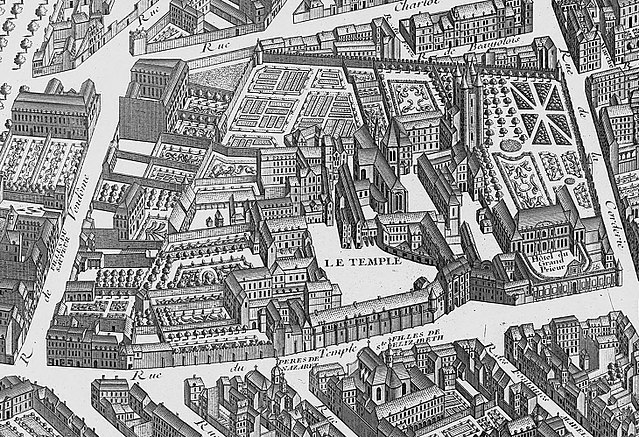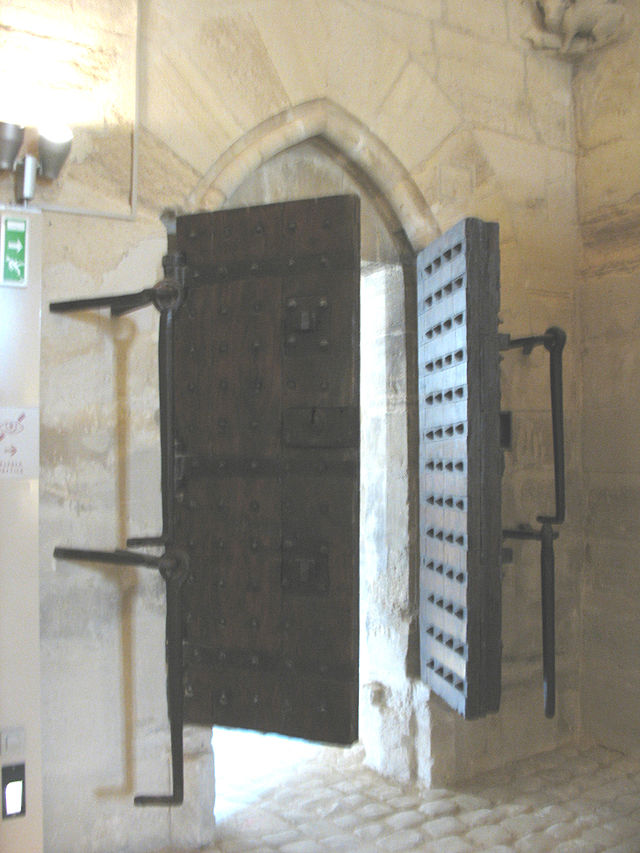Square du Temple
Garden in Paris, France From Wikipedia, the free encyclopedia
Garden in Paris, France From Wikipedia, the free encyclopedia
The Square du Temple is a garden in Paris, France in the 3rd arrondissement, established in 1857. It is one of 24 city squares planned and created by Georges-Eugène Haussmann and Jean-Charles Adolphe Alphand. The Square occupies the site of a medieval fortress in Paris, built by the Knights Templar. Parts of the fortress were later used as a prison during the French Revolution, and then demolished by the mid-19th century.
You can help expand this article with text translated from the corresponding article in French. (August 2015) Click [show] for important translation instructions.
|
| The Paris Temple | |
|---|---|
| Paris, France | |
 A view of the Grosse Tour-circa 1795, Ecole Française 18th century. | |
| Type | Medieval fortress |
| Site information | |
| Condition | Demolished |
| Site history | |
| Built | mid-13th century |
| Built by | Knights Templar |
| Demolished | 1808 |
| Events | French Revolution |

The order of the Knights Templar began in the 12th century, first constructing a fort (Vieux Temple or Old Temple) in Le Marais. In the 13th century, a new fortress was built as their European headquarters. The enclosure, called enclos du Temple, originally featured a number of buildings important to the running of the order, and included a church and a massive turreted keep known as Grosse Tour (great tower), which housed a number of the order's prized possessions, and a smaller tower called Tour de César (Caesar's Tower).
The location of the towers is drawn on the ground in front of the Mairie de Paris Centre (town hall),[1] on the rue Eugène Speller. The heavy doors of the Grosse Tour still exist and are kept at Château de Vincennes, whose great keep, attributed to Raymond du Temple of Notre-Dame cathedral, is thought to have been inspired by the nearby Templar fortress.[2][clarification needed]
It was here in the enclos du Temple on the morning of Friday, the 13th of October, 1307 that agents of Philip IV of France arrested Templar Grand Master Jacques de Molay charging him with heresy. Philip was deep in debt to the Templars due mainly to the 1294–1303 Gascon War with Edward I of England. Philip acted with the approval of Pope Clement V who also desired the dissolution of the Knights Templar. Clement V had annulled the papal bull Unam Sanctam proclaiming papal supremacy over secular rulers, giving Philip legal authority to arrest the Templars. Philip confiscated the immense wealth of the French Templars. Jacques de Molay was burned at the stake for heresy without trial on March 18, 1314, where the Square du Vert Galant stands in Paris today.[3][4]
The Temple is also known for having been the place where the French royal family was jailed at the time of the French Revolution. Members of the royal family imprisoned at the Temple's tower were:
By 1808, the Temple had become a place of pilgrimage for royalists, so Napoleon ordered its demolition, which took two years. Remnants were demolished around 1860 under orders from Napoleon III.
Today its location is a station of the Paris Metro, serving the carreau du temple (covered market) and the Palais de Justice (Courthouse) of the third arrondissement.
The garden includes a gazebo, a playground for children, lawns with the largest open to the public from 15 April to 15 October, fountains and a pond with an artificial waterfall, built from rocks brought in from the forest of Fontainebleau. The grid surrounding the square was designed by the architect Gabriel Davioud. The square contains almost 200 varieties of plants, including many exotic species, such as hazel, a Ginkgo biloba, a Honey locust of America, a Pterocarya fraxinifolia, goldenrain tree, Cedrela, and Chinese quince.
In 2007, the square received the "ecological green spaces" awarded by ECOCERT, the international organic certification.
There are two statues. One represents the songwriter Pierre-Jean de Béranger, who lived on the nearby street which later took his name. This is the second statue of him; a first bronze statue, by Amédée Donatien Doublemard, was erected with a public subscription held in 1879 by the newspaper "La Chanson", and was destroyed in 1941. It was replaced in 1953 with the present stone statue, by Henri Lagriffoul.
Another statue, a bust on a pedestal, is dedicated: "To B. Wilhelm 1781-1842, founder of the French Orphéon" above a medallion portrait that bears the inscription "To Eugène Delaporte 1818-1886, propagator".
On 26 October 2007, a monument was inaugurated on the lawn of the main square of the Temple. It carries the names and ages of 85 "little ones who did not have time to attend school", Jewish children from 2 months to 6 years living in the 3rd arrondissement and deported between 1942 and 1944 and then murdered in Auschwitz. This monument was unveiled in the presence of several hundred people, city and district elected officials, representatives of associations and the Sons and Daughters of Jewish Deportees from France. The memorial is one of several honouring the 11,400 Jewish children deported from France. The lists of children were compiled from school and civic records by Serge Klarsfeld.

Seamless Wikipedia browsing. On steroids.
Every time you click a link to Wikipedia, Wiktionary or Wikiquote in your browser's search results, it will show the modern Wikiwand interface.
Wikiwand extension is a five stars, simple, with minimum permission required to keep your browsing private, safe and transparent.